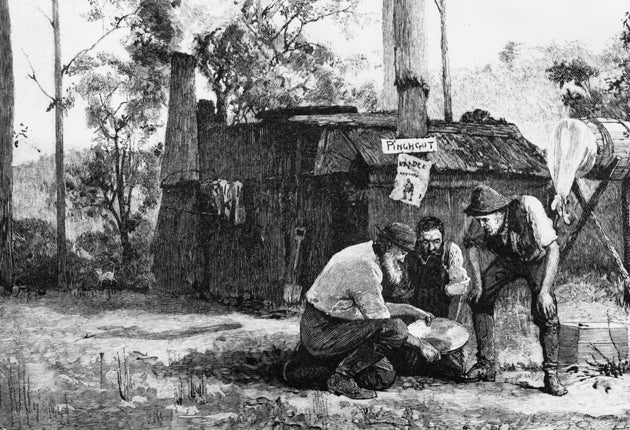Australia banks on return of gold-rush fever
Echoes of the 1850s as reserves worth up to £40bn are discovered in Victoria. Kathy Marks reports

Your support helps us to tell the story
From reproductive rights to climate change to Big Tech, The Independent is on the ground when the story is developing. Whether it's investigating the financials of Elon Musk's pro-Trump PAC or producing our latest documentary, 'The A Word', which shines a light on the American women fighting for reproductive rights, we know how important it is to parse out the facts from the messaging.
At such a critical moment in US history, we need reporters on the ground. Your donation allows us to keep sending journalists to speak to both sides of the story.
The Independent is trusted by Americans across the entire political spectrum. And unlike many other quality news outlets, we choose not to lock Americans out of our reporting and analysis with paywalls. We believe quality journalism should be available to everyone, paid for by those who can afford it.
Your support makes all the difference.News of the discovery of gold in Australia's colony of Victoria in 1851 brought miners flocking from all over the world. The population soared and the colony boomed, with Melbourne and provincial centres enjoying undreamt-of prosperity, the fruits of which are still visible today in its wide boulevards and grand Victorian architecture.
Now the heady days of the mid-19th century could return, with the identification of vast new reserves of the precious metal in northern Victoria. A geological survey suggests that up to 70 million ounces of gold lie beneath the ground – nearly as much again as the state's total output over the past 150 years.
But modern-day prospectors are being warned to think twice before jumping on a plane to Melbourne. Unlike in the 1850s, when people literally picked nuggets up off the ground, the gold is tantalisingly out of reach, buried under hundreds of feet of sediment and waste rock. Only mining companies using advanced drilling techniques will be able to extract it. "It will be a corporate gold rush this time," said Paul McDonald, the resources manager at Geoscience Victoria, the state government agency that conducted the three-year survey. "It's not quite as romantic, but the gold itself is still romantic. It's just a bit harder to get at."
With gold prices at record highs this year, the mining industry has been intensifying its search for new reserves. In Australia, one of the world's leading producers, exploration has focused mainly on the rich goldfields of Western Australia, where mothballed mines have been reopened. The results of the survey could divert efforts back to Victoria – or so the state government hopes.
The 19th-century gold rush, which began two years after a similar frenzy in California, was prompted by discoveries at Ballarat, Bendigo and Beechworth, as well as in a clutch of smaller towns. The area came to be known as the Golden Triangle. Now, using remote-sensing technology, government geologists have identified a new triangle to the north, with the same host rock found between 150ft and 1,800ft underground.
For the moment, mining companies are being cautious, pointing out that the precious metal is difficult and costly to extract at such depths. Peter Thompson, the exploration manager of Beaconsfield Gold, said the gold in Victoria was also coarse-grained, rather than finely distributed through the rock. "So you can drill a hole and find a big nugget, or find nothing at all," he said. "Nevertheless, it's exciting to think that there are still big discoveries to be made."
Chris Fraser, executive director of the Victoria division of the Minerals Council of Australia, said: "We agree with the government that there's enormous potential there. But it's not a find yet, it's just a scientific study. Gold is a ruthless business, it's not for the faint-hearted. Only one in 1,000 exploration projects ever turns into a mine. These deposits are like looking for a needle in a haystack. You're mining ounces in a vast landscape."
Since 1851, when the world's richest gold rush began in Victoria, 80 million ounces of gold have been dug up. If Geoscience Victoria's predictions prove correct, there could be, based on current prices, about £40.5bn worth of the precious metal still lying underground.
The original rush, which started weeks after the colony was founded and lasted until the late 1860s, attracted miners from as far afield as Britain, Ireland, Italy, Germany, China and the US. The Chinese, in particular, arrived in large numbers, and their presence on the goldfields led to tensions, riots and, eventually, the White Australia policy, which restricted non-white immigration for much of the 20th century.
The Australian population nearly trebled within a decade of gold being found, and the population of Victoria – where the economy had previously been based on sheep grazing – soared from 75,000 to more than half a million. Rural backwaters became wealthy towns, and by the 1880s the colony's capital was being called Marvellous Melbourne, one of the world's largest and most cosmopolitan cities.
The latest gold rush, if it happens, is likely to be less revolutionary in its impact. However, enormous riches await those who strike lucky. "It's not going to pop out of the ground this time, but the prizes are immense," Mr Fraser said.
Join our commenting forum
Join thought-provoking conversations, follow other Independent readers and see their replies
Comments